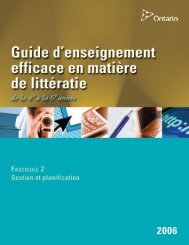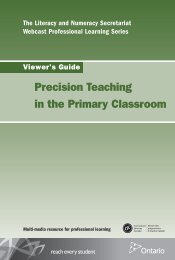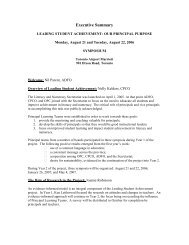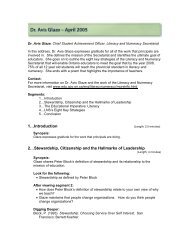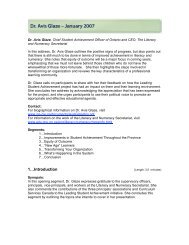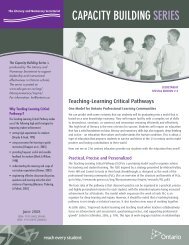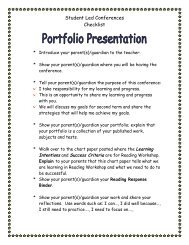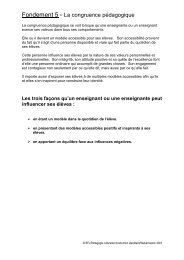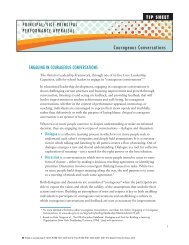Developing Inquiring Minds Viewer's Guide - Curriculum Services ...
Developing Inquiring Minds Viewer's Guide - Curriculum Services ...
Developing Inquiring Minds Viewer's Guide - Curriculum Services ...
You also want an ePaper? Increase the reach of your titles
YUMPU automatically turns print PDFs into web optimized ePapers that Google loves.
The Literacy and Numeracy SecretariatWebcast Professional Learning SeriesViewer’s <strong>Guide</strong><strong>Developing</strong><strong>Inquiring</strong> <strong>Minds</strong>Multi-media resource for professional learning
On this DVD you will find a Print and Video Resources folder which containsWMV files for PowerPoint presentations and this <strong>Viewer's</strong> <strong>Guide</strong> in PDF.To order the multi-media package <strong>Developing</strong> <strong>Inquiring</strong> <strong>Minds</strong>Contact ServiceOntario416-326-5300 or 1-800-668-9938http://www.publications.serviceontario.ca/ecomThe webcast segments and related resources are also accessible online athttp://www.curriculum.org/secretariat/inquiring/index.shtml.This resource may be copied for not-for-profit educational purposes.Funded by the Literacy and Numeracy Secretariat, Ministry of Education.
OverviewIn this resource you will see students and teachers actively engaged in learningabout learning – all highly reflective, action-oriented and determined tounderstand themselves as key players in the teaching-learning process.They engage in ongoing self-assessment, seek feedback, take action andmonitor their progress in order to move their learning forward. Each memberof the learning community, teachers and students, assumes an inquiry stancethat impacts on his or her thinking and actions.The teachers in this video take a highlyreflective, honest look at their ownpractice and seek ways to change thatwill result in improved student learningand achievement. The teachers build intime to reflect, interact and talk abouttheir work in order to construct newknowledge and understandings. Theyengage in inquiry related to their ownpractice and the needs of their students.For these teachers, teaching becomes veryintentional. Through their design-downplanning and ongoing assessment, theycreate open-ended learning experiencesthat are inclusive of all students. They offerstudents real choice and an opportunity todevelop their own voice. The focus is onlearning the curriculum content usingthe inquiry process and developing digitaland critical literacy.“When teachers join forces withtheir students in the formativeassessment process, their partnershipgenerates powerful learningoutcomes. Teachers become moreeffective, students become activelyengaged and they both becomeintentional learners.”(Brookhart & Moss, 2009)A strong sense of respect exists which empowers students and teachers tofully participate, take risks, and learn from, with and on behalf of each other.Students become more independent, metacognitive and aware of the relevanceand value of what they are learning. Through self-assessment and reflection,students learn to talk about themselves as learners and identify their strengthsand needs.3
The Grade 2 classroom environment you will see is intentionally designedto help students develop into articulate, critical thinkers and learners. Therespectful culture of the classroom invites all students to participate in theteaching-learning process. All children feel valued as part of their learningcommunity. Students follow their own interests, formulate their own inquiryquestions and select their preferred method of learning and sharing.The wonder and joy of learning is evident in this classroom as studentsexcitedly talk about their unexpected discoveries and new wonderings. In thisclassroom, students seek and act on peer and teacher feedback, think abouttheir thinking, work collaboratively and question respectfully. They learn totake a critical stance when interpreting any sort of information. These studentsare becoming critical and competent communicators. They are developingthe habits of mind necessary for success in a rapidly changing world.4
WEBCAST SEGMENTSIntroduction (Duration: 0:51)This Grade 2 classroom environment is intentionally designed to help studentsdevelop into independent and articulate thinkers and learners. Therespectful culture of the classroom invites all students to participate in theteaching-learning process. Each child feels valued as part of this learningcommunity. Students follow their own interests, formulate their own inquiryquestions and select their preferred method of learning and sharing. In thisclassroom, students seek and act on peer and teacher feedback, think abouttheir thinking, work collaboratively and question respectfully. They are developingthe habits of mind necessary for success in a rapidly changing world.In your opinion, what are the essential habits of mind that students needto develop in order to be successful during their school years and beyond?How might understanding this context impact on your practice?You may wish to consult the following two resources as you formulate yourthinking:The Conference Board of Canada Employability Skillshttp://calsca.com/conference_board.htmThe Institute for Habits of Mindhttp://www.instituteforhabitsofmind.com/what-are-habits-mindTeachers Demonstrate EffectiveDescriptive Feedback (Duration: 15:33)Using appropriate and respectful vocabulary, two teachers share their ownmoon journals and give each other feedback. Students deepen their appreciationof the value of descriptive feedback and gain insight into how to give andreceive descriptive feedback. They reflect on the demonstration and co-createsuccess criteria for effective feedback sessions.What teaching and learning experiences do you think occurred prior to thisdescriptive feedback session which supported the richness of the conversation?5
Moderation of Student Work (Duration: 16:28)Two teachers analyze student writing to determine an individual student’sstrengths and needs. They discuss next steps for their student as a writerand possible student grouping for differentiated instruction. Dialoguebetween the teachers is rich, positive, focused and purposeful.Analyzing student writing yields important information about what studentsare able to do and also about areas that need improvement.What information does student work yield for teachers about their ownpractice?What questions would you ask of yourself as you think about your student(s)and their writing?The Student’s Perspective (Duration: 5:35)Students talk about how motivated they are to learn and the wonder theyfeel as they discover more and more interesting information through theirinquiries. They appreciate the choices they have in how they are learningand how they will demonstrate that learning.What are the benefits of an inquiry approach to learning for the students?What are the benefits of an inquiry approach to learning for the teacher?What might be the greatest challenge associated with an inquiry approachto teaching?How might you deal with this challenge?“As we increasingly move toward an environment of instantand infinite information, it becomes less important forstudents to know, memorize or recall information, and moreimportant for them to be able to find, sort, analyze, share,discuss, critique and create information. They need to movefrom being simply knowledgeable to being knowledge-able.”(Wesch, 2008)7
Classroom Tour (Duration: 8:59)This classroom environment helps to create a strong community of independentlearners. Students are engaged in inquiry about the moon. They delve deeplyinto areas of personal interest and are excited about the new knowledge theyare building.What aspects of this learning environment lead to developing independentlearners?What evidence do you see of authentic learning and of the teacher takingthe lead from her students?“Understanding the facts of a story or a content area is ofundisputed importance. But for these facts to come to life,they need to be connected to larger patterns of meaning;they need to be in the service of topical research, criticalinquiry, and literacy, and they need to be functional andapplicable to the world beyond the text.”(Wilhelm, 2007)8
Further ThinkingYou may wish to consider the following questions relating to your own practicewith your study group or for personal reflection:Adopting the inquiry approach to learning has many benefits. What do yourecognize as being the most beneficial aspect of this approach to the teacherand to the student?What challenges might you need to consider before you introduce this typeof learning to your students or before you engage in a professional inquiry?How does inquiry learning nurture intellectual curiosity? Why is this curiosityan important attribute to develop in students?How does the inquiry approach to learning impact on the development ofmetacognition in students?Which aspects of critical literacy does an inquiry approach address, and how?In what ways might students be involved in self-assessment during inquirylearning?ReferencesBrookhart, B., & Moss, C. (2009). Advancing formative assessment in everyclassroom: A guide for instructional leaders. Alexandria, VA: ASCD.Wesch, M. (2008). A portal to media literacy. The University of Manitoba.Podcast retrieved from http://umanitoba.ca/ist/production/streaming/podcast_wesch.html.Wilhelm, J. (2007). Engaging readers and writers with inquiry. New York:Scholastic.9
Technical InstructionsHow to Access the Print and Video ResourcesTo access the Print and Video Resources folder in Windows, insert the DVDinto the DVD drive of your computer and:1. Click on the Start menu.2. Select My Computer.3. Right-click the mouse on the DVD icon titled DEVELOPING_INQUIRING_MINDS_DVD to open a drop-down options list.4. From the drop-down list, select and click on the Open option.5. Double-click on the folder titled Print and Video Resources to access thefiles. Ignore the folders titled Audio_TS and Video_TS.6. Select the resources you wish to use directly from this folder, ORCopy onto the Desktop and open files from the Desktop.Alternatively, when the DVD is inserted and the options box opens:1. Select the option Open Folder to View Files.2. Click on the Print and Video Resources folder.3. Select the files you wish to use directly from this folder, ORCopy the files onto the Desktop and open them from the Desktop.To access the Print and Video Resources folder in Mac OS X, insert the DVDinto the DVD drive of your computer and:1. Exit from the DVD player (which typically opens automatically when aDVD is inserted in the drive).2. Double-click on the DVD icon titled DEVELOPING_INQUIRING_MINDS_DVD.3. Select the files you wish to use directly from this folder, ORCopy the files onto the Desktop and open them from the Desktop.10
How to Save the Video Files to Your ComputerThe video files can all be copied and saved to your computer using eitherof the following methods for copying and pasting files.Method 11. Right-click on the file and choose the Copy option.2. Right-click within any computer folder into which you would like tosave the file, and choose the Paste option.Method 21. Left-click the mouse on the file you want to save, so that the file ishighlighted.2. Simultaneously press the Ctrl and C keys (or, for Macintosh users,the Command and C keys) to copy the file.3. Left-click within any computer folder in which you would like to savethe file, and simultaneously press the Ctrl and V keys (or, for Macintoshusers, the Command and V keys) to paste the file there.• For Macintosh users, the Command key is the one with theNOTE:If you want to insert video files into a PowerPoint presentation, you mustsave these video files in the same folder that contains your PowerPoint file.If you save a PowerPoint presentation to another location (e.g., a memory stick,CD-ROM, etc.), you must also save the video files in the same location inorder for the video to play. So, if you transfer the presentation to anothercomputer, you must also transfer the video files with it, or else the videowill not link to the PowerPoint presentation.11
How to Insert Video Clips (WMV files) into a PowerPointPresentationOn this DVD you will find WMV versions of all segments of the webcast.To insert a clip into a PowerPoint presentation, follow the directions below:1. Open your PowerPoint program.2. Create a new PowerPoint presentation OR open an existing PowerPointpresentation, and within it, open the slide on which you would like toadd the video.3. Insert the webcast DVD into the DVD drive of your computer.4. If a new window opens asking how you would like to view the files on thedisk, choose the option Open Folder to View Files; ORIf a new window does not open, open the My Computer window from theStart menu. In the My Computer window, double-click on the icon thatis shaped like a disk, which will likely be labelled D: or E:.5. Save the video segment that you want to insert in a PowerPoint into thesame folder that contains your PowerPoint presentation.NOTE: Video files that have been saved to your computer can be croppedand edited into smaller segments using Movie Maker (free on PCs) oriMovie (free on Macintosh).6. Open the PowerPoint slide on which you would like to insert the video,and click on the Insert menu in the PowerPoint menu bar.7. From the Insert menu, select Movies and Sounds, and click on the Moviefrom File option.8. A window opens, prompting you to select the video file that you wouldlike to add. Find and select the video file that you saved in step 5.9. Once you have chosen the video file you need, another window opensand asks whether you want your movie to play either automatically whenyou enter the slide, or only when it is clicked. Choose your preference.(You will notice that the starting image of your movie is not displayedon the slide.)12
Notes13
Printed on recycled paperISBN 978-1-4435-4735-2 (Kit)© Queen’s Printer for Ontario, 2010





